gearbox Citroen DS5 2016 1.G Owner's Guide
[x] Cancel search | Manufacturer: CITROEN, Model Year: 2016, Model line: DS5, Model: Citroen DS5 2016 1.GPages: 500, PDF Size: 55.11 MB
Page 120 of 500
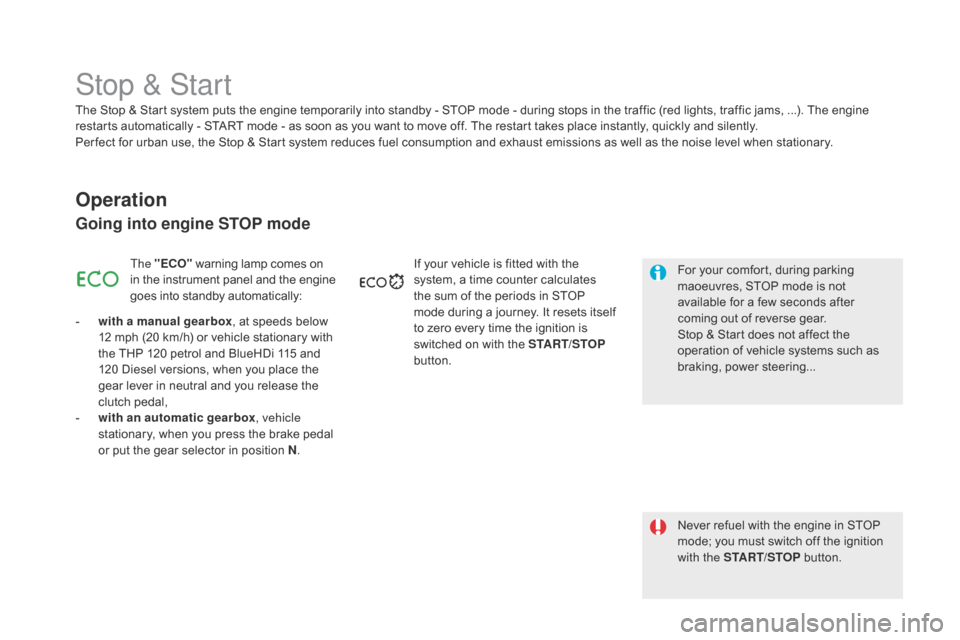
DS5_en_Chap04_conduite_ed02-2015
Stop & Start
Operation
Going into engine STOP mode
The "EcO" w arning lamp comes on
in the instrument panel and the engine
goes into standby automatically:
-
wi
th a manual gearbox , at speeds below
12 mph (20 km/h) or vehicle stationary with
the THP 120 petrol and BlueHDi 115 and
120 Diesel versions, when you place the
gear lever in neutral and you release the
clutch pedal,
-
wi
th an automatic gearbox , vehicle
stationary, when you press the brake pedal
or put the gear selector in position N .If your vehicle is fitted with the
system, a time counter calculates
the sum of the periods in STOP
mode during a journey. It resets itself
to zero every time the ignition is
switched on with the START/STOP
button.
Never refuel with the engine in STOP
mode; you must switch off the ignition
with the START/STOP button.
For your comfort, during parking
maoeuvres, STOP mode is not
available for a few seconds after
coming out of reverse gear.
Stop & Start does not affect the
operation of vehicle systems such as
braking, power steering...
The Stop & Start
s
ystem puts the engine temporarily into standby - STOP mode - during stops in the traffic (red lights, traffic jams, ...). The engine
restarts automatically - START mode - as soon as you want to move off. The restart takes place instantly, quickly and silently.
Per fect for urban use, the Stop & Start system reduces fuel consumption and exhaust emissions as well as the noise level when stationary.
Page 121 of 500

11 9
DS5_en_Chap04_conduite_ed02-2015
Special cases: STOP mode not
available
STOP mode is not invoked when:
- the vehicle is on a steep slop (rising or
falling),
-
th
e driver's door is open,
-
th
e driver's seat belt is not fastened,
-
th
e vehicle has not exceeded 6 mph
(10
k
m/h) since the last engine start using
the START/STOP button,
-
th
e electric parking brake is applied or
being applied,
-
th
e engine is needed to maintain a
comfortable temperature in the passenger
compartment,
-
de
misting is active,
-
so
me special conditions (battery charge,
engine temperature, braking assistance,
ambient temperature...) where the engine is
needed to assure control of a system.
In this case, the "E
cO" w
arning lamp
flashes for a few seconds then
goes off.
This operation is perfectly normal.
Going into engine START mode
The "EcO" w arning lamp goes off
and the engine starts automatically:
-
wi
th a manual gearbox , when you fully
depress the clutch pedal,
-
wi
th an automatic gearbox :
●
ge
ar selector in position
d o
r M, when
you release the brake pedal,
●
or g
ear selector in position N and brake
pedal released, when you place the gear
selector in position
d o
r M,
●
or w
hen you engage reverse. As a safety measure or to maintain comfort
levels in the vehicle, START mode is invoked
automatically when:
-
yo
u open the driver's door,
-
yo
u unfasten the driver's seat belt,
-
th
e speed of the vehicle exceeds 15
m
ph
(25 km/h) with a manual gearbox (2
m
ph
(3
k
m/h) with THP 210 petrol and
BlueHDi
1
15 and 120 Diesel versions), or
2
m
ph (3
k
m/h) with an automatic gearbox,
-
th
e electric parking brake is being applied,
-
so
me special conditions (battery charge,
engine temperature, braking assistance,
ambient temperature...) where the engine is
needed for control of a system.
Special cases: START invoked
automatically
In this case the "EcO" w arning lamp
flashes for a few seconds, then
goes off.
This operation is perfectly normal.
driving
Page 135 of 500
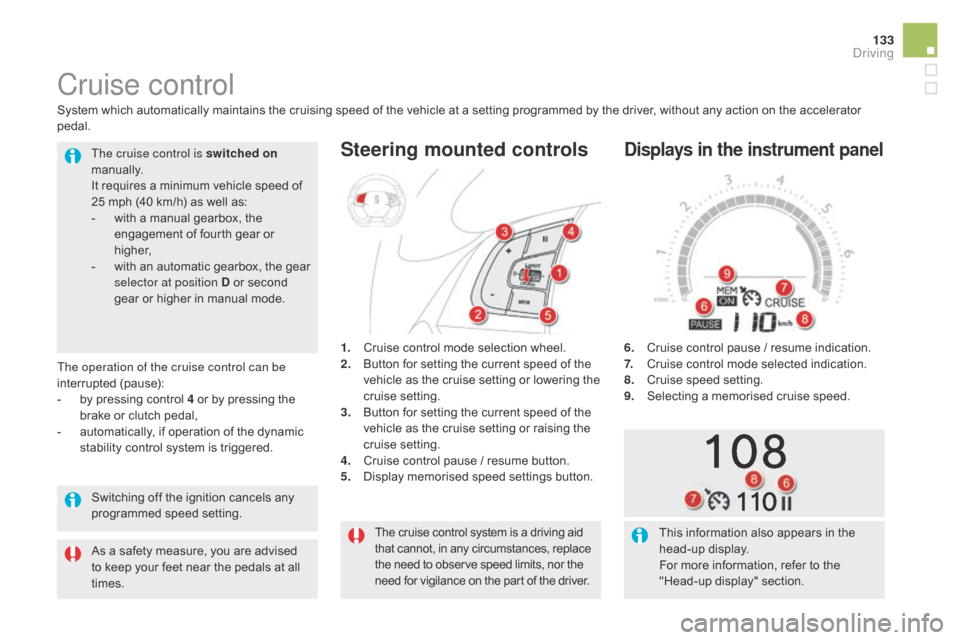
133
DS5_en_Chap04_conduite_ed02-2015
The cruise control system is a driving aid
that cannot, in any circumstances, replace
the need to observe speed limits, nor the
need for vigilance on the part of the driver.
Cruise control
1. Cruise control mode selection wheel.
2. Bu tton for setting the current speed of the
vehicle as the cruise setting or lowering the
cruise setting.
3.
Bu
tton for setting the current speed of the
vehicle as the cruise setting or raising the
cruise setting.
4.
Cr
uise control pause / resume button.
5.
Di
splay memorised speed settings button.
Steering mounted controls
6. Cruise control pause / resume indication.
7. Cr uise control mode selected indication.
8.
Cr
uise speed setting.
9.
Se
lecting a memorised cruise speed.
displays in the instrument panelThe cruise control is switched on
manually.
It requires a minimum vehicle speed of
25 mph (40 km/h) as well as:
-
wi
th a manual gearbox, the
engagement of fourth gear or
higher,
-
wi
th an automatic gearbox, the gear
selector at position
d o
r second
gear or higher in manual mode.
This information also appears in the
head-up display.
For more information, refer to the
"Head-up display" section.
System which automatically maintains the cruising speed of the vehicle at a setting programmed by the driver, without any action on the accelerator
pedal.
Switching off the ignition cancels any
programmed speed setting.
The operation of the cruise control can be
interrupted (pause):
-
by p
ressing control 4 or by pressing the
brake or clutch pedal,
-
au
tomatically, if operation of the dynamic
stability control system is triggered.
As a safety measure, you are advised
to keep your feet near the pedals at all
times.
driving
Page 208 of 500
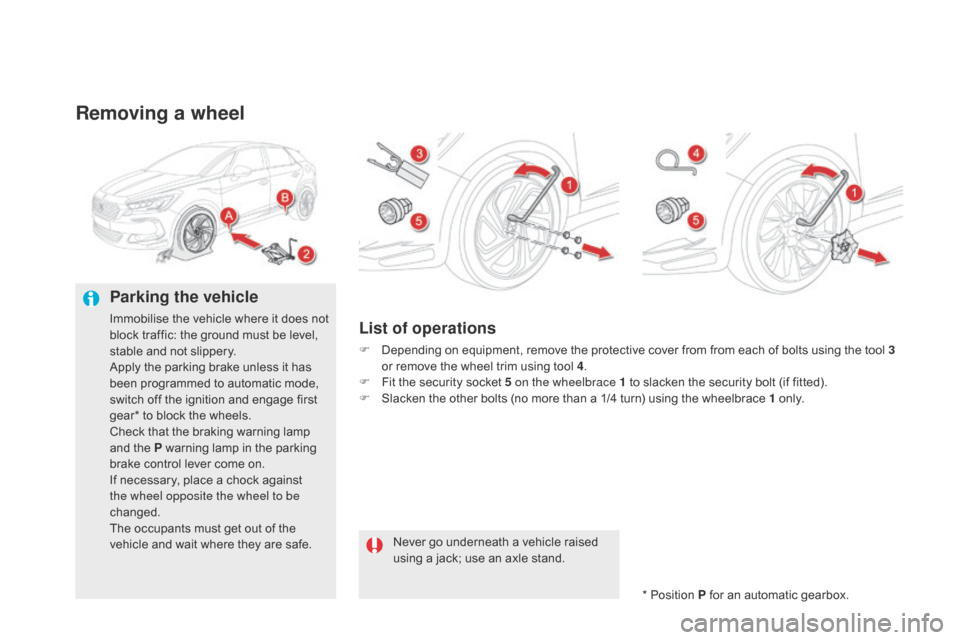
DS5_en_Chap08_info-pratiques_ed02-2015
Removing a wheel
Parking the vehicle
Immobilise the vehicle where it does not
block traffic: the ground must be level,
stable and not slippery.
Apply the parking brake unless it has
been programmed to automatic mode,
switch off the ignition and engage first
gear* to block the wheels.
Check that the braking warning lamp
and the P warning lamp in the parking
brake control lever come on.
If necessary, place a chock against
the wheel opposite the wheel to be
changed.
The occupants must get out of the
vehicle and wait where they are safe.List of operations
F Depending on equipment, remove the protective cover from from each of bolts using the tool 3
or remove the wheel trim using tool 4 .
F
Fi
t the security socket 5 on the wheelbrace 1 to slacken the security bolt (if fitted).
F
Sl
acken the other bolts (no more than a 1/4 turn) using the wheelbrace 1 o n l y.
* Position P for an automatic gearbox.
Never go underneath a vehicle raised
using a jack; use an axle stand.
Page 225 of 500

223
DS5_en_Chap08_info-pratiques_ed02-2015
12 V battery
The battery is located under the bonnet.
To gain access to it:
F
op
en the bonnet using the interior release
lever, then the exterior safety catch,
F
ra
ise the plastic cover on the (+) terminal.
Access to the battery
Protect your eyes and face before
handling the battery.
All operations on the battery must be
carried out in a well ventilated area and
away from naked flames and sources
of sparks, so as to avoid the risk of
explosion or fire.
Wash your hands after wards.
Procedure for starting the engine using another battery or charging a discharged battery.
General points
Lead-acid starter batteries
Batteries contain harmful substances
such as sulphuric acid and lead.
They must be disposed of in
accordance with regulations and must
not, in any circumstances, be discarded
with household waste.
Take used remote control batteries and
vehicle batteries to a special collection
point.
If your vehicle has an automatic
gearbox, do not try to start the engine
by pushing the vehicle.
Versions equipped with Stop & Start are
fitted with a 12 V lead-acid battery of
specific technology and specification.
Its replacement should be carried out
only by a CITROËN dealer or a qualified
workshop.
The battery (-) terminal is not accessible.
A remote earth point is provided at the front of
the vehicle.
For access to it:
F
un
clip the plastic cover, located alongside
the left-hand headlamp.
Practical information
Page 231 of 500

229
DS5_en_Chap08_info-pratiques_ed02-2015
General recommendations
Observe the legislation in force in your country.
Ensure that the weight of the towing vehicle is higher than that of the towed vehicle.
The driver must remain at the wheel of the towed vehicle and must have a valid driving
licence.
When towing a vehicle with all four wheels on the ground, always use an approved towing
arm; rope and straps are prohibited.
The towing vehicle must move off gently.
When towing a vehicle with the engine off, there is no longer any power assistance for
braking or steering.
In the following cases, you must always call on a professional recovery service:
-
ve
hicle broken down on a motor way or fast road,
-
fo
ur-wheel drive vehicle,
-
wh
en it is not possible to put the gearbox into neutral, unlock the steering, or release
the parking brake,
-
to
wing with only two wheels on the ground,
-
wh
ere there is no approved towing arm available...
Towing the vehicle
Access to the tools
The towing eye is stowed in the boot under the
f l o o r.
To gain access to it:
F
op
en the boot,
F
ra
ise the boot floor,
F
ta
ke out the towing eye, located in the
storage well.
Procedure for having your vehicle towed or for towing another vehicle using a removable towing eye.
Practical information
Page 232 of 500
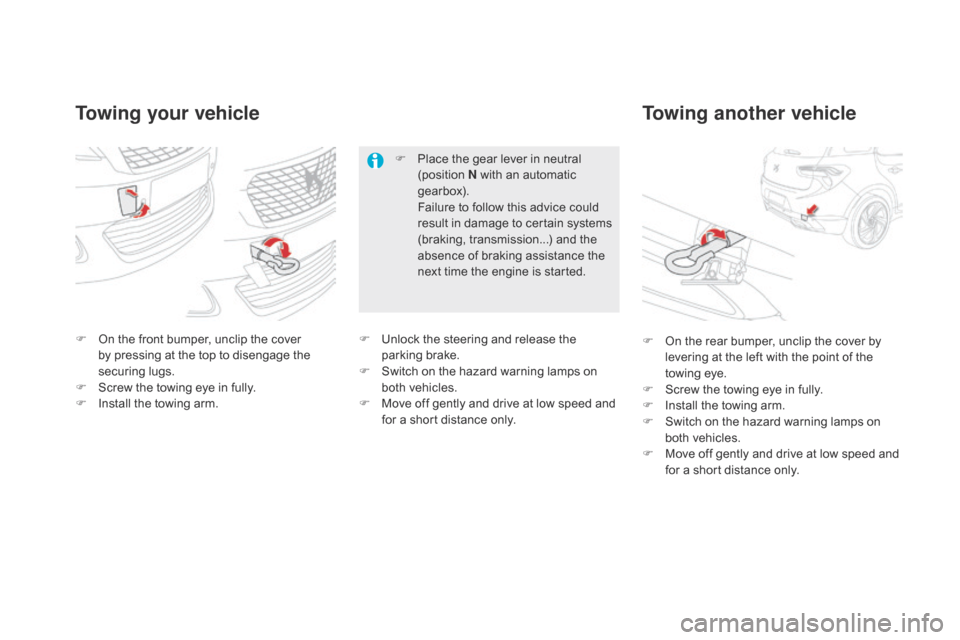
DS5_en_Chap08_info-pratiques_ed02-2015
Towing your vehicleTowing another vehicle
F On the front bumper, unclip the cover
b
y pressing at the top to disengage the
securing lugs.
F
Sc
rew the towing eye in fully.
F
In
stall the towing arm. F On t
he rear bumper, unclip the cover by
levering at the left with the point of the
towing eye.
F
Sc
rew the towing eye in fully.
F
In
stall the towing arm.
F
Sw
itch on the hazard warning lamps on
both vehicles.
F
Mov
e off gently and drive at low speed and
for a short distance only.
F
Pl
ace the gear lever in neutral
(position N with an automatic
gearbox).
Fa
ilure to follow this advice could
result in damage to certain systems
(braking, transmission...) and the
absence of braking assistance the
next time the engine is started.
F Un lock the steering and release the
parking brake.
F
Sw
itch on the hazard warning lamps on
both vehicles.
F
Mov
e off gently and drive at low speed and
for a short distance only.
Page 254 of 500

DS5_en_Chap09_verifications_ed02-2015
Brake wear depends on the style
of driving, particularly in the case
of vehicles used in town, over short
distances. It may be necessary to
have the condition of the brakes checked, even
between vehicle services.
Unless there is a leak in the circuit, a drop in
the brake fluid level indicates that the brake
pads are worn.
Brake pads
For information on checking brake
disc wear, contact a CITROËN dealer
or a qualified workshop.
Brake disc wear Electric parking brake
This system does not require any
routine servicing. However, in the
event of a problem, have the system
checked by a CITROËN dealer or a
qualified workshop.
Only use products recommended by
CITROËN or products of equivalent
quality and specification.
In order to optimise the operation of
units as important as those in the
braking system, CITROËN selects and
offers very specific products.
After washing the vehicle, dampness,
or in wintry conditions, ice can form
on the brake discs and pads: braking
efficiency may be reduced. Make light
brake applications to dry and defrost
the brakes.
For more information on the electric parking
brake, refer to the corresponding section.
Manual gearbox
The gearbox does not require any
maintenance (no oil change).
Refer to the manufacturer's service
schedule for the checking interval for
this component.
Automatic gearbox
The gearbox does not require any
maintenance (no oil change).
Refer to the manufacturer's service
schedule for details of the level
checking interval for this component.
Page 266 of 500
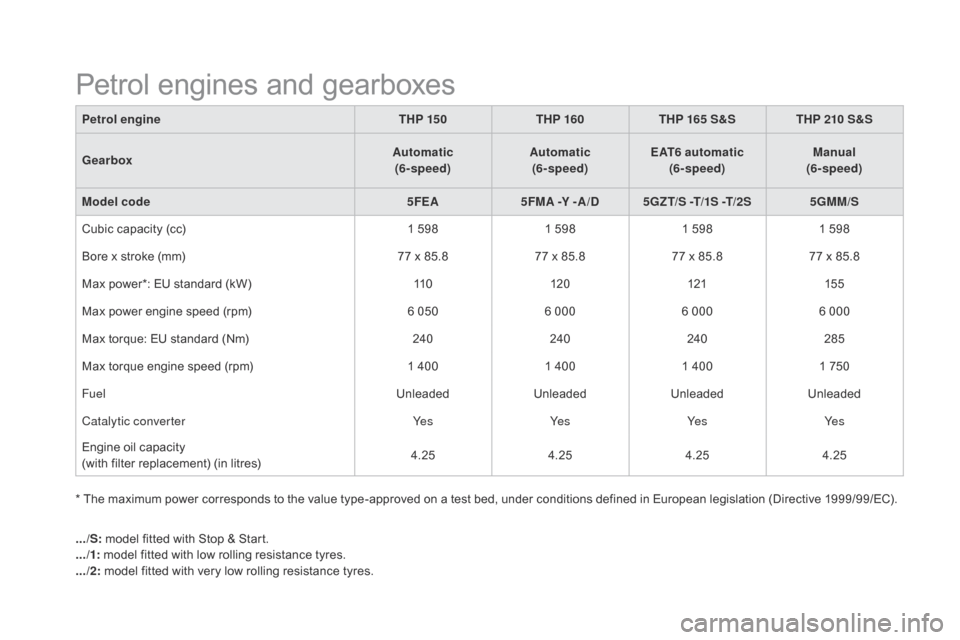
DS5_en_Chap10_caracteristiques_ed02-2015
Petrol engineTHP 15 0THP 160 THP 165 S&S THP 210 S&S
Gearbox Automatic
(6- speed) Automatic
(6- speed) EAT6 automatic
(6- speed) Manual
(6- speed)
Model code 5FEA5FMA -Y -A /
d5G
ZT/S -T/1S -T/2S5GMM/S
Cubic capacity (cc) 1 5981 5981 5981 598
Bore x stroke (mm) 77 x 85.877 x 85.877 x 85.877 x 85.8
Max power*: EU standard (kW) 11 0120 121155
Max power engine speed (rpm) 6 0506 000 6 0006 000
Max torque: EU standard (Nm) 240240240285
Max torque engine speed (rpm) 1 4001 4001 400 1 750
Fuel UnleadedUnleadedUnleadedUnleaded
Catalytic converter Ye sYe sYe sYe s
Engine oil capacity
(with filter replacement) (in litres) 4.25
4.254.254.25
Petrol engines and gearboxes
* The maximum power corresponds to the value type-approved on a test bed, under conditions defined in European legislation (Directive 1999/99/EC).
.../S: model fitted with Stop & Start.
.../1: model fitted with low rolling resistance tyres.
.../2: model fitted with very low rolling resistance tyres.
Page 267 of 500

265
DS5_en_Chap10_caracteristiques_ed02-2015
Petrol weights and towed loads (in kg)
Petrol engineTHP 15 0THP 160 THP 165 S&S THP 210 S&S
Gearbox Automatic
(6- speed) Automatic
(6- speed) EAT6 automatic
(6- speed) Manual
(6- speed)
Model code 5FEA5FMA -Y -A /
d5G
ZT/S -T/1S -T/2S5GMM/S
-
Un
laden weight 1 4951 495 1 4291 430
-
Ke
rb weight* 1 5701 5701 504 1 505
-
Gr
oss vehicle weight (GV W) 2 0302 030 2 0172 010
-
Gr
oss train weight (GTW)
on a 1
2 % gradient 2 830
2 830 3 1172 760
-
Br
aked trailer (within GTW limit)
on a 1
0 % or 12 % gradient 800
8001 100 750
-
Br
aked trailer** (with load transfer within the
GTW limit) 800
8001 400 1 050
-
Un
braked trailer 74 574 5750 750
-
Re
commended nose weight 75757575
* The kerb weight is equal to the unladen weight + driver (75 kg).
**
Th
e weight of the braked trailer can be increased, within the GTW limit, if the GV W of the towing vehicle is reduced by an equal amount; warning,
towing using a lightly loaded towing vehicle may have an adverse effect on its road holding.
The GTW and towed load values indicated are valid up to a maximum altitude of 1 000 metres; the towed load mentioned must be reduced by 10 % for
each additional 1 000 metres of altitude.
When towing the maximum authorised speed is reduced (comply with the legislation in force in your country).
High ambient temperatures may result in a reduction in the per formance of the vehicle to protect the engine; if the ambient temperature is above 37 °C,
limit the towed load.
Technical data